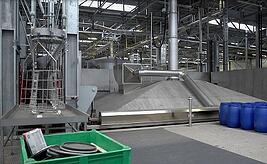 Simadan Holding, a company operating in the global raw material markets, has built a new state-of-the-art production complex in Amsterdam. Within the facility, its subsidiary Rotie operates a plant for the processing of fat and organic waste to produce biodiesel. Odour control is a major issue, as the factory is required to use the best technologies available to minimise the smell escaping the facility.
Simadan Holding, a company operating in the global raw material markets, has built a new state-of-the-art production complex in Amsterdam. Within the facility, its subsidiary Rotie operates a plant for the processing of fat and organic waste to produce biodiesel. Odour control is a major issue, as the factory is required to use the best technologies available to minimise the smell escaping the facility.
The company searched for the most effective technologies with the aim of reducing odour levels by at least 90% while maximising energy efficiency. It identified two innovative solutions: plasma filtration for the hall where organic waste is processed and Colt’s electrostatic filter for the fat processing hall.
Plasma filtration in a waste processing plant: a first
With plasma filtration the odours are neutralised at the source: oxygen molecules are given an electric charge and break down the odour molecules into their original components, neutralising the odour.
The main benefits of this solution are the extremely low energy consumption and the small number of components in the plasma system. In addition, plasma filtration cleans the air by deactivating any fungi or bacteria it may be carrying.
The Rotie facility is the first waste processing plant using plasma filtration, so extensive testing and analyses were completed to ensure its effectiveness, and the system is now up and running successfully.
Electrostatic filtration: best solution for fat processing plant
The fat is processed in melting bunkers, where it is heated at 800C for 10 to 12 hours, until it melts. Each fat melting bunker is closed with two lids to keep the heat and smell in. When the lids are opened to allow a fresh supply of fat to be added, the emission of odour needs to be prevented.
Colt’s solution is to use an industrial air curtain to insure 90% of the air remains inside the bunker when the lids are opened. An air extraction system then deals with the 10% that escapes and moves it up to the roof, where the fat particles in the air are removed through electrostatic filtration, removing the smell.
Innovative thinking that works
These innovative solutions not only have enabled Rotie to comply with odour control regulations; they also resulted in a significant improvement in working conditions inside the facility, as these systems dramatically reduce odour levels inside as well as outside. And all this using very little energy.
If this article has piqued your interest, you can learn more about this in this video, where Kem Veenstra, the plant manager, shows you around the facility and explains the two innovative odour control systems.
If you think these systems may be the solution for your project, you can contact Stefan van der Velden, Colt’s expert in these new technologies.
View the full case history on the Colt Group website.
 Stefan van der Velden is Colt's Senior Consultant for Climate Control in the Netherlands.
Stefan van der Velden is Colt's Senior Consultant for Climate Control in the Netherlands.

